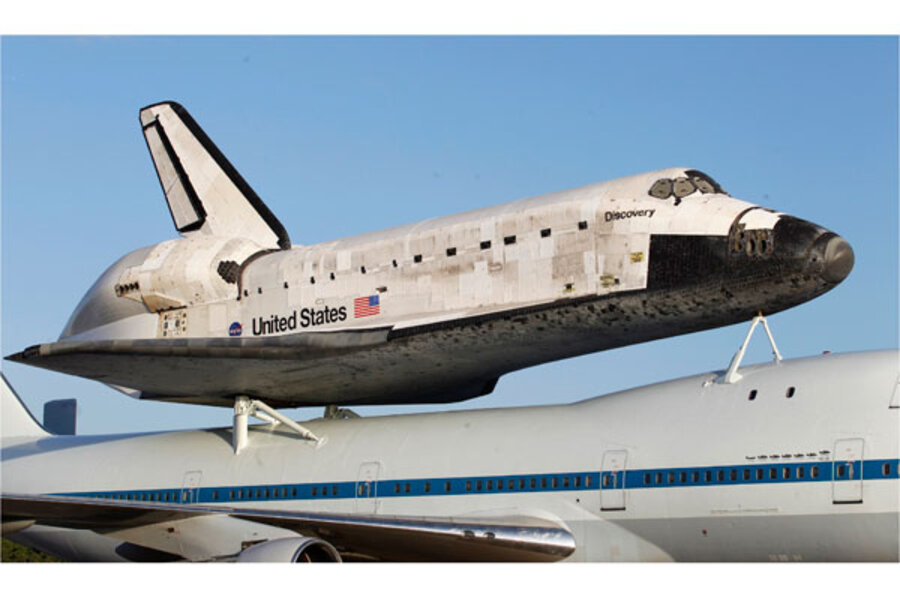Space Shuttle Discovery mounted on 747 for ride to Smithsonian
Loading...
NASA mounted space shuttle Discovery on a jumbo jet Sunday (April 15), in preparation for the retired orbiter's delivery to the Smithsonian. The paired air- and spacecraft are expected to depart Florida for Washington, D.C., on Tuesday morning (April 17), weather permitting.
Discovery's mating to the Shuttle Carrier Aircraft (SCA), NASA's modified Boeing 747 jetliner, came a day later than the space agency had planned. On Saturday, wind gusts at the Kennedy Space Center's Shuttle Landing Facility set the 167,000 pound (75,300 kilogram) Discovery swaying under its lift sling, posing a risk that it could impact the Mate Demate Device (MDD), the gantry-like steel structure used to hoist the shuttle onto the jetliner.
Workers reconvened at 5 a.m. EDT (0900 GMT) on Sunday, to finish retracting the shuttle's landing gear. They then raised the orbiter 60 feet (18 meters) off the ground so that the carrier aircraft could be positioned underneath. Discovery was then lowered onto the jumbo jet's three protruding attach points to achieve a "soft" mating.
Work continued throughout the day Sunday to secure, or "hard" mate, Discovery to the 747, before removing the hoist sling and backing the paired vehicles out of the MDD on Monday morning. [How Space Shuttles Fly on 747 Jets (Photos)]
Emotional ending
"Assuming the weather is good, we'll back out [of the Mate-Demate Device] in the morning, That will give a whole day of opportunity for the media, the public, and for our employees to come out and get a good view of Discovery's last time on top of a 747 here at Kennedy Space Center," said Stephanie Stilson, flow director for the transition and retirement for the space shuttle orbiters. [Gallery: Discovery Mated to Jumbo Jet]
Among the space program workers expected to come out and view Discovery on Monday are the members of its 39th and final spaceflight, the six astronauts who flew the STS-133 mission in March 2011.
According to Stilson, who also led the ground processing for Discovery's last 11 missions, seeing it be readied for one last ferry flight was eliciting mixed feelings.
"It's hard not to be happy, because we have achieved another one of our goals," Stilson told collectSPACE.com. "That is how we look at things. We have a job to do, and that is to get Discovery to the Smithsonian. So this is the next step to get there. So we're very happy because everything has gone well to get to this point."
"But then, when I start to think about the fact that this is last time to do this with Discovery, it is sad," she continued. "It is not something that we want to have as a last opportunity. But that's part of the job, that is where we are with the program and the way things are going."
"So I'm just going to enjoy it, be happy and allow myself to really see the team at their best. Even if this is one of the last times we do it, at least they're doing it to the best of their ability, very professional, very dedicated and who can't be happy about that? It's a great experience," Stilson said.
Final ferry flight
Discovery's mating with the Shuttle Carrier Aircraft marked a final reunion for the space shuttle and jumbo jet. The same aircraft was used to first deliver Discovery to the Kennedy Space Center on Nov. 9, 1983.
In the three decades since, Discovery was paired with this Shuttle Carrier Aircraft, NASA 905, for 14 out of its 18 ferry flights.
"This is something we have done many times before," said Stilson. "We have the same exact Mate-Demate Device out in California at the Dryden Flight Research Center so if we landed out west, we would go through the same process to get the orbiter that landed out there back home to Kennedy. And then, when we used to do maintenance periods out in California, we would load up from here [in Florida] and then ferry out to Palmdale."
Two large cranes will take the place of the Mate-Demate Device when the Shuttle Carrier Aircraft arrives with Discovery at Washington Dulles International Airport on Tuesday (April 17).
After a day spent offloading the orbiter, NASA and the Smithsonian will hold an arrival ceremony on Thursday (April 19) when Discovery will be rolled over to the National Air and Space Museum's Steven F. Udvar-Hazy Center, located adjacent to the airport.
Visit shuttles.collectspace.com for continuing coverage of the delivery and display of NASA's retired space shuttles.
Follow collectSPACE on Facebook and Twitter @collectSPACE and editor Robert Pearlman @robertpearlman. Copyright 2012 collectSPACE.com. All rights reserved.







